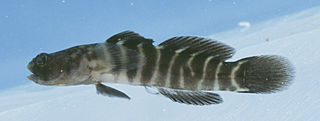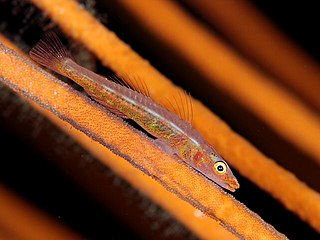
Mudskippers are any of the 23 extant species of amphibious fish from the subfamily Oxudercinae of the goby family Oxudercidae. They are known for their unusual body shapes, preferences for semiaquatic habitats, limited terrestrial locomotion and jumping, and the ability to survive prolonged periods of time both in and out of water.

Mugilogobius is a genus of fish in the family Gobiidae. They are found in fresh, brackish and marine water of the Indo-Pacific region. Several of the freshwater species have highly restricted distributions.

The Gobiiformes are an order of fish that includes the gobies and their relatives. The order, which was previously considered a suborder of Perciformes, is made up of about 2,211 species that are divided between seven families. Phylogenetic relationships of the Gobiiformes have been elucidated using molecular data. Gobiiforms are primarily small species that live in marine water, but roughly 10% of these species inhabit fresh water. This order is composed chiefly of benthic or burrowing species; like many other benthic fishes, most gobiiforms do not have a gas bladder or any other means of controlling their buoyancy in water, so they must spend most of their time on or near the bottom. Gobiiformes means "goby-like".

The Atlantic mudskipper is a species of mudskipper native to fresh, marine, and brackish waters of the tropical Atlantic coasts of Africa, including most offshore islands, through the Indian Ocean and into the western Pacific Ocean to Guam. The Greek scientific name Periophthalmus barbarus is named after the eyes that provide the Atlantic mudskipper with a wide field of vision. The Atlantic mudskipper is a member of the genus Periophthalmus, which includes oxudercine gobies that have one row of canine-like teeth.

Apocryptodon is a genus of gobies native to the Indian Ocean and the western Pacific Ocean.
Caecogobius cryptophthalmus is a species of goby that is endemic to underground habitats in Calbiga on the Philippine island of Samar. This species is one of two members of the genus Caecogobius. Like other cavefish, C. cryptophthalmus has reduced eyes and pigmentation.
Eugnathogobius is a genus of gobies native to fresh, brackish and marine waters of the Indian Ocean and the western Pacific Ocean region.
Gnatholepis is a genus of fish in the family Gobiidae, the gobies. It is the only marine genus in the subfamily Gobionellinae, which otherwise includes mostly estuary-dwelling and freshwater fish. Gnatholepis are tropical fish associated with sandy habitat around corals.

Gobiosoma is a genus of gobies native to fresh, brackish and marine waters of the Americas.

Bryaninops amplus, known commonly as the large whip goby or white-line seawhip goby, is a species of marine fish in the family Gobiidae.

Oxuderces is a genus of fish in the family Gobiidae native to fresh and brackish waters of coasts of the Indian and Pacific Ocean.
Platygobiopsis is a genus of gobies native to the western Pacific Ocean.
Eugnathogobius siamensis is a species of goby.
Darwin's mudskipper is a relatively newly discovered mudskipper in 2004, so little is known about it. It is a brackish water ray-finned fish found in Australia along mud banks never far from mangrove trees. It is in the goby family Gobiidae. It is named after Charles Darwin because the holotype was collected in Darwin Harbour. Its greatest distinguishing characteristic from other mudskippers is its greatly reduced first dorsal fin in both sexes.
Pseudogobiopsis lumbantobing is a species of goby from the subfamily Gobionellinae which is found in Java and Sumatra where it occurs in freshwater rivers and streams at altitudes of 5–22 metres (16–72 ft), with substrates made up of sand, gravel, rock, and boulders and where there may be growths of algae and aquatic macrophytes. This species has been traded in the European aquarium trade since 2001.
Helen K. Larson is an ichthyologist who specialises in the fishes of the Indo-Pacific.
Platygobiopsis hadiatyae is a species of goby, commonly known as a Renny's flat goby.
The Wirz's goby, Oxuderces wirzi, is a species of goby found in Oceania from Papua New Guinea and northern Australia.

Oxuderces dentatus, is a species of goby found in the Indo-West Pacific from India, to Vietnam, to Macau, China, Malaysia and Indonesia.









